“Tsukiji (‘filled-in ground’), the one-time Foreign Concession, occupies a strip of land facing the bay at the S. edge of the city in Kyobashi-ku, and with its several museums, the big Seiyoken Hotel, etc., contains consider able of interest.
“Foreigners were formerly confined to this quarter, the approaches to which were guarded by sentinels. It is now the favorite dwelling-place of numerous foreign missionaries, whose houses and the foreign-style churches make it resemble the suburb of some Western city. Many schools and deserving establishments for the moral and intellectual advancement of the people are maintained by the mission-workers in various parts of the metropolis.
“The most successful among these envoys are often those who possess a medical or scientific training, and who blend the necessary material with the spiritual education. Not a few missionaries in Japan have rendered eminent service in this way. The Charity Hospital, adjoining the Naval Medical College, is well equipped and was opened in March, 1912. St. Luke’s Hospital is in Akashicho, near the American Church. The Type Foundry was the first of its kind established in Japan.”
– Terry’s Japanese Empire, T. Philip Terry, 1914
See also:
Hotel Metropole, Tsukiji
Seiyoken Hotel, Tsukiji
St. Luke’s International Hospital, Tsukiji
Rikkyo (St. Paul’s) University, Tsukiji
“As a foreign commercial centre, early Tokyo was a failure. From the beginning the shallowness of Tokyo Harbour doomed to failure the Tsukiji Foreign Settlement as a center of trade.
“The Settlement faced the [Sumida] river and was moated on all sides by canals. It reminded foreigners far too much of the island of Deshima, in Nagasaki, on which Dutch trade had been confined for over two hundred years, and created in the minds of some the impression that another Deshima was being attempted in Tokyo.
“The land entrance to the Settlement was guarded by a watch house with Japanese soldiers, but as they were more generally afraid of the two-sworded ronin than the ronin were of them, they were not always effective.
“… Until the railway line connecting Yokohama and nearby Shimbashi was opened in 1872, communications between the two foreign settlements were maintained by four-horse coaches, called the Yedo Mail. The journey took four hours and the terminal point in Tokyo was Hall’s Store, which was located not far from the present site of St. Luke’s Hospital … There was an alternative route by sea in a small steamer named the ‘City of Yedo’ which left the English Hatoba in Yokohama in the morning for Tsukiji and returned to Yokohama at night.”
– Tales of Foreign Settlements in Japan, by Harold Williams, 2012
“A large proportion of the buildings in the Foreign Concession are devoted to religious and educational purposes, testifying to the zeal of the various missionary bodies whose members form the bulk of the population.
“The most conspicuous places of worship are the Cathedral of the Protestant Episcopal Church of America and the Roman Catholic Cathedral. Another striking building is the Hotel Metropole situated on the Bund facing the Sumida-gawa near its mouth. Beyond the river lies Ishikaioa-jima where stands a large Convict Prison.
“The land is gaining rapidly on the water in this district, the whole spit opposite the Bund having been reclaimed within the last five and twenty years. On a fine breezy day, the vessels sailing into the river mouth add picturesque animation to the scene.”
– A Handbook for Travellers in Japan, by Basil Hall Chamberlain & W. B. Mason, 1901
- Hotel Metropole, Tsukiji, c. 1905.
- Hotel Seiyoken, Tsukiji, c. 1910.
Tokugawa Japan was forced from its self-imposed seclusion in 1853 by the arrival of Perry’s “Black Ships.” Unable to realistically defend itself against the greater firepower arrayed by the Western powers (principally Great Britain, France and the United States), the Shogunate had little choice but to sign away certain extraterritorial rights in exchange for preserving peace and national sovereignty. The concessions, made official by the 1854 Kanagawa Treaty, became known as the “Unequal Treaties.” Eliminating these concessions became the principal motivation behind the formation of the Satsuma, Choshu, and Tosa clan alliance that would overthrow the Shogunate and restore Imperial primacy in 1868.
Part and parcel with the concessions went the establishment of “foreign settlements” [kyoryuchi] in Nagasaki, Kobe, Yokohama and Edo/Tokyo: restricted residential areas for Western traders and missionaries that existed outside the reach of Japanese law. In Tokyo, Tsukiji [Reclaimed land] was chosen as the location of its foreign settlement in 1869. Built upon reclaimed land, interlaced with canals and bridges, the district was thought to be safely removed from the center of government and easily isolated in the event of violent conflict. Contrary to initial expectations, the Tsukiji settlement area was not able to develop into a trading area to the extent Yokohama became a major port. Instead, Western nations sited legations in Tsukiji, and the settlement became a leading entry point for the importation of Western culture into Tokyo. Japan’s first Western-style hotels (the Hoterukan, Seiyoken and Metropole) were built in the Tsukiji Foreign Settlement. Carriages, and gas lighting (and, later, electricity) first appeared there. Foreign dress and customs were also observed and imitated. The settlement became home to diplomats, missionaries and teachers. Several institutions that continue today were founded within the Foreign Settlement including St. Luke’s Hospital, the International Catholic Hospital, Rikkyo (St. Paul’s) University, and the American School in Japan.
Upon promulgation of the Meiji Constitution in 1889, the unequal treaties were repealed, the extraterritorial concessions lifted and, from 1899 onward, foreigners were no longer restricted in their travels or their place of work and residence within Tokyo. Many continued to live in the area for several years, though, by which time the modernizing of Japan had radically and completely changed how the country was being governed, educated, and entertained.
All that remains today of Tsukiji’s early foreign influence is St. Luke’s Hospital. After the 1923 Great Kanto earthquake city authorities chose to relocate the last of Nihonbashi’s produce merchants and fishmongers to the site of the former Foreign Concession. Tsukiji Fish Market grew to become the world’s largest and, perhaps, most famous marketplace for fresh and frozen seafood, selling on average 1.3 billion pounds of seafood each year from the 1,677 wholesale stalls that cover its 56 acres.


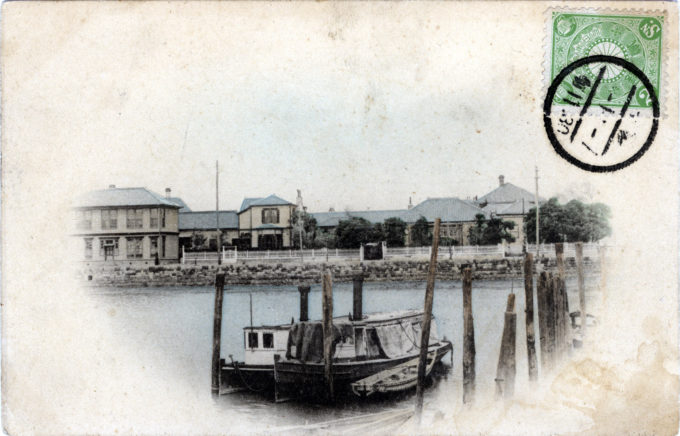
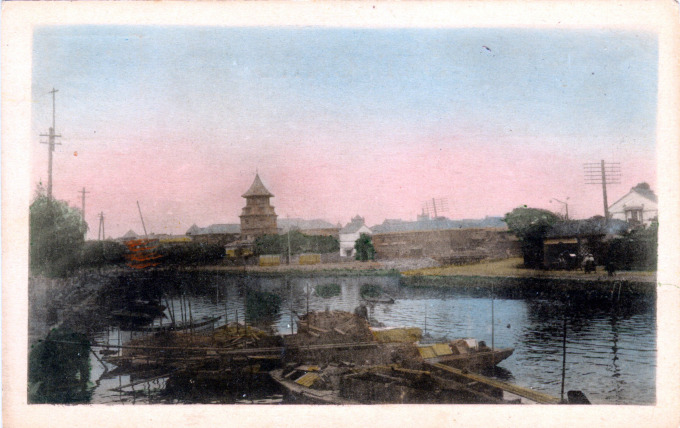
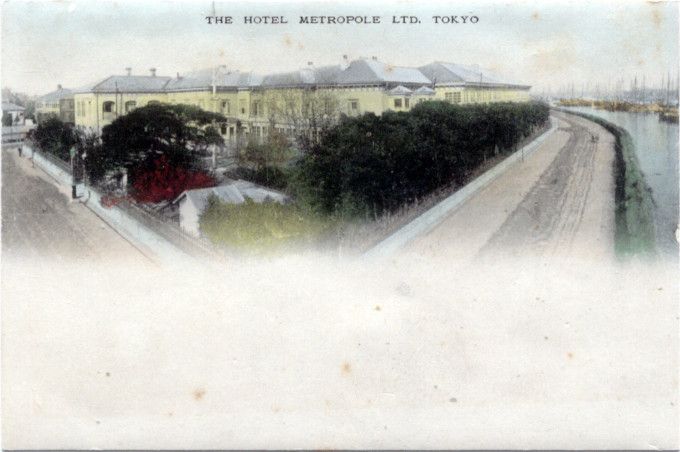
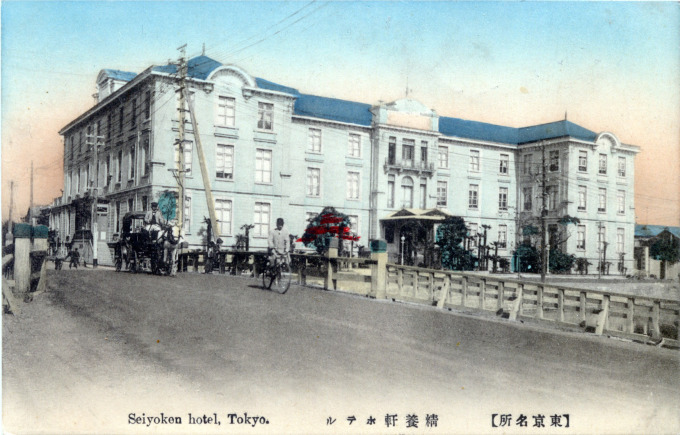
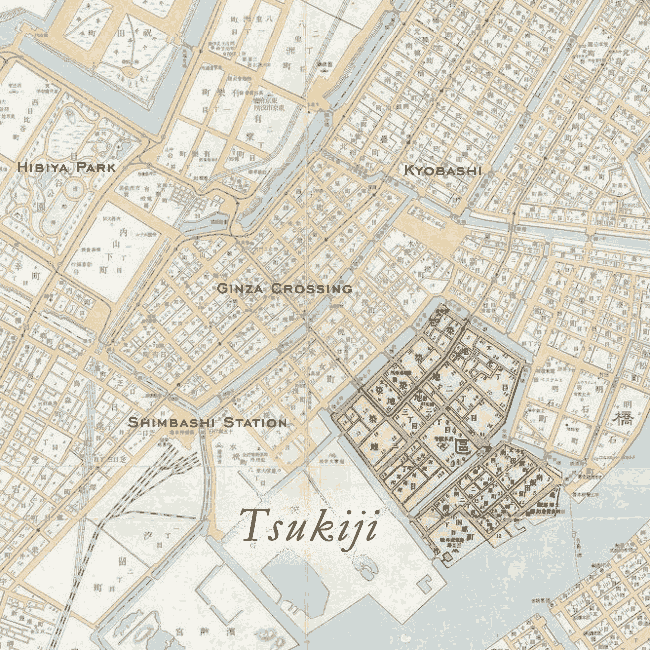
Pingback: Hongan-ji Temple, Tsukiji, c. 1935 | Old Tokyo
Pingback: St. Luke’s International Hospital, Tsukiji, c. 1945-50. | Old Tokyo
Pingback: Hotel Metropole, Tsukiji, c. 1905. | Old Tokyo
Pingback: Hotel Metropole (former US Legation), Tsukiji, c. 1905. | Old Tokyo
Pingback: Seiyoken Hotel, Tsukiji, c. 1910. | Old Tokyo
Pingback: Rikkyo (St. Paul's) University | Old Tokyo
Pingback: Teishin-sho (Ministry of Communications), Tsukiji, c. 1900. | Old Tokyo
Pingback: Uogashi (Fish Market) at Nihonbashi, c. 1910. | Old TokyoOld Tokyo
Pingback: Ambassador’s residence, U.S. Embassy, Akasaka, Tokyo, c. 1950. | Old TokyoOld Tokyo
Pingback: Meiji Gakuin University, Skirokane, Tokyo, c. 1920. | Old TokyoOld Tokyo